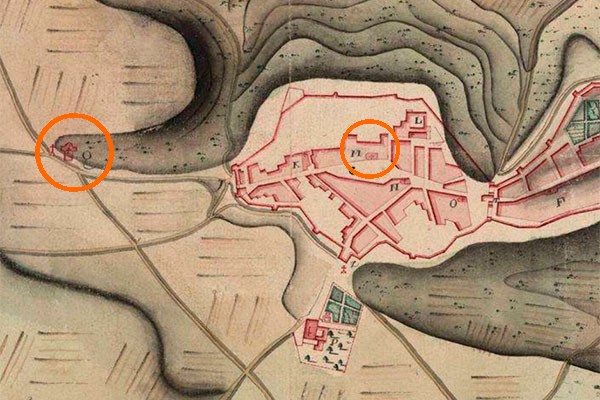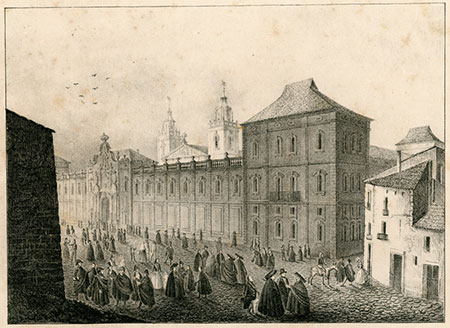
On the left the chapel of Onze Mil Verges
On the right the monastery, now University
Detail of Plano de la ciudad de Cervera (1724)
Biblioteca Virtual de Defensa
The Poor Clares arrived in Cervera in 1349, establishing themselves in the chapel of the Onze Mil Verges, located outside the city walls. The early years of the community were difficult, leading them in 1372 to request relocation to other houses of the order. After a temporary move, the community secured a new site where they could settle—precisely the spot where the University would later be built. The construction of the new monastery was made possible thanks to the support of Bernat Berenguer Llompart, Lord of Montcortès.

Built over the monastery of Santa Clara and the hospital of Castelltort
Engraving by F. X. Parcerisa. Private collection
The life of the community remained fragile, and in 1594 it came to an end with the death of the only nun who still resided there. In 1467, a community of Franciscans, who had lost their convent due to war, had arrived in that part of the city and took up residence, sharing space with the Castelltort hospital. The dissolution of the Poor Clares offered a temporary solution to the situation: in 1592, the former Franciscan convent was handed over to the Minims of Sant Francesc de Paula, and the Poor Clares’ monastery was taken over by the hospital. In 1603, work was carried out on the church, but the building was eventually demolished, and the site was drastically altered to make way for the construction of the new University, whose foundation stone was laid in 1718.
- COSTA, Xavier; SANCHO, Marta; SOLER-SALA, Maria (2017). Monacato femenino y paisaje. Los monasterios de clarisas dentro del espacio urbano en la Catalunya medieval. Clarisas y dominicas. Firenze: Firenze University Press
- DURAN I SANPERE, Agustí (1977). Llibre de Cervera. Barcelona: Curial
- SANAHUJA, Pedro (1959). Historia de la seráfica provincia de Cataluña. Barcelona: Ed. Seráfica
- Link ↗ : Claustra
Today, no remains of the monastery survive; it once stood on the site now occupied by the University
